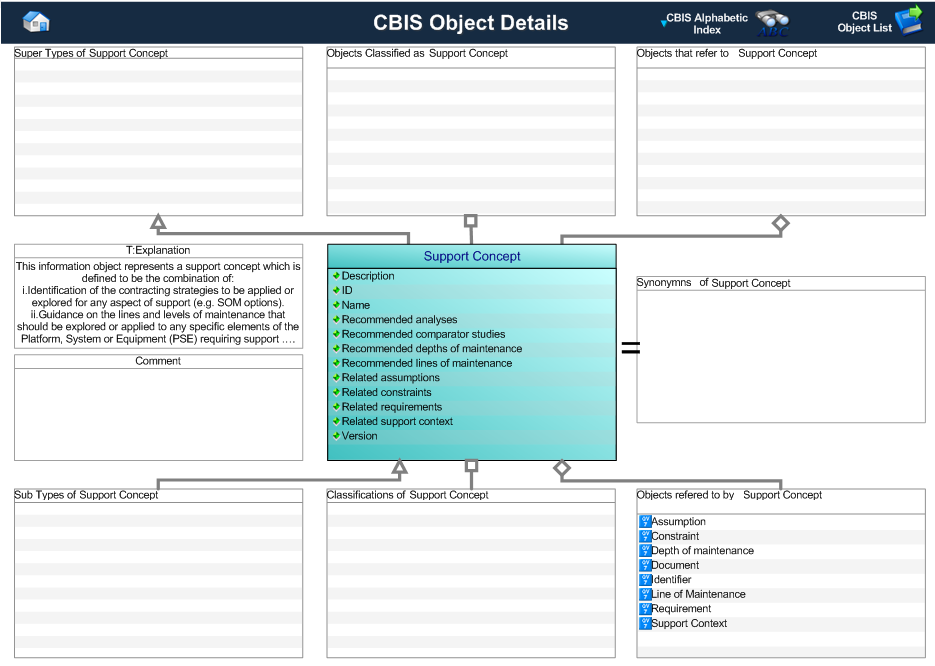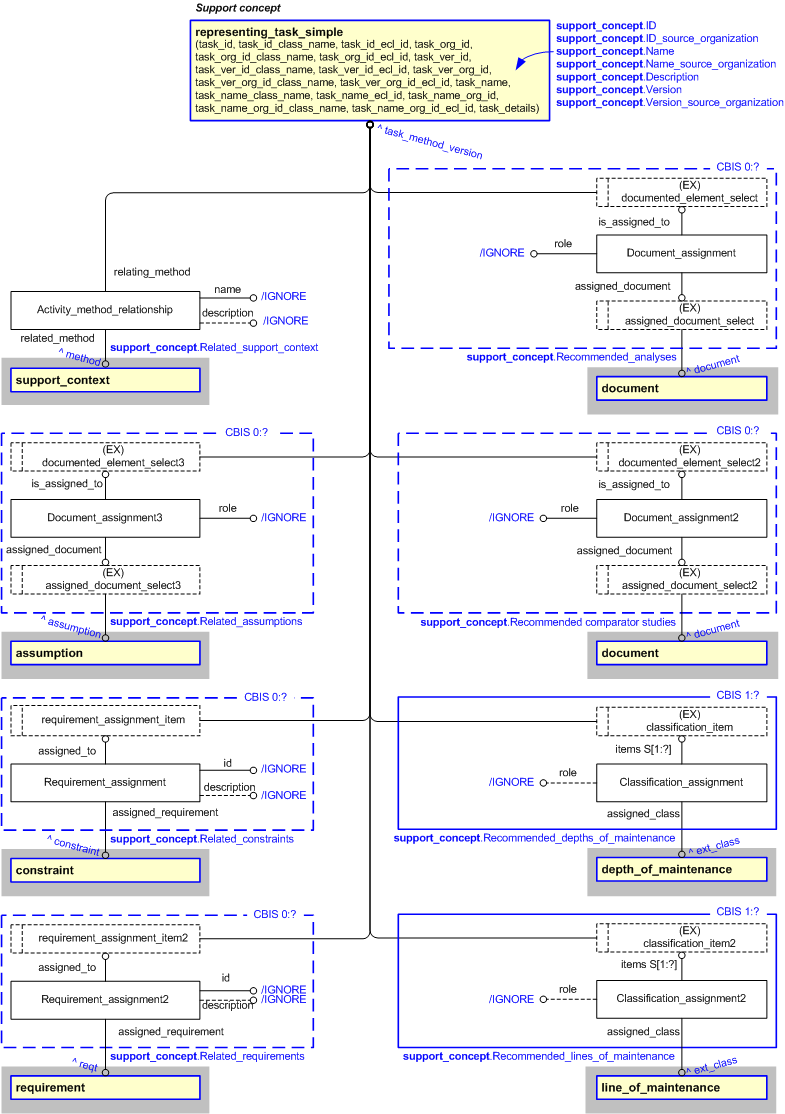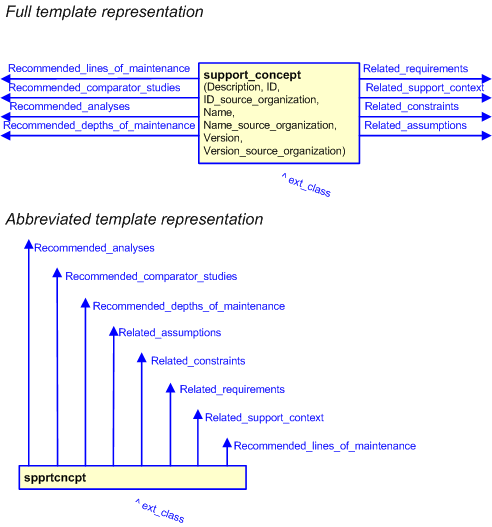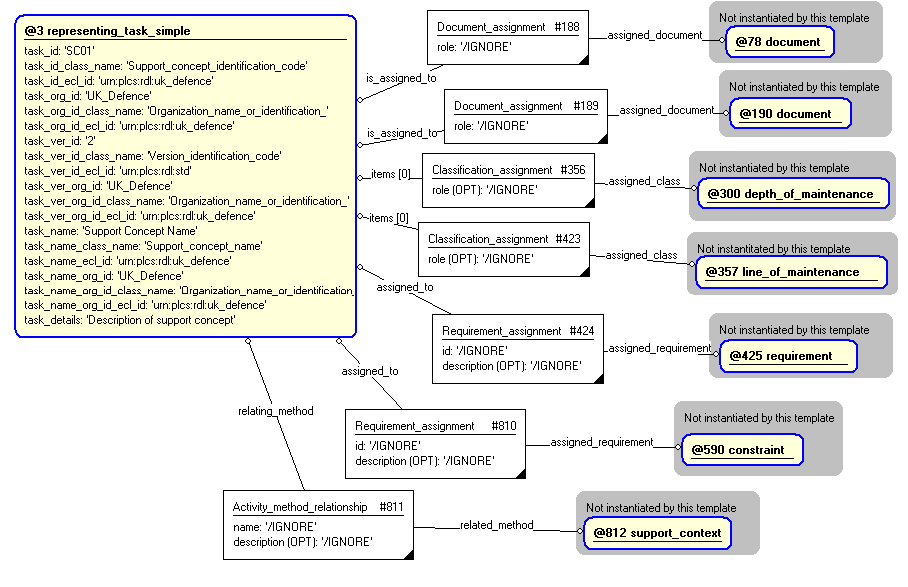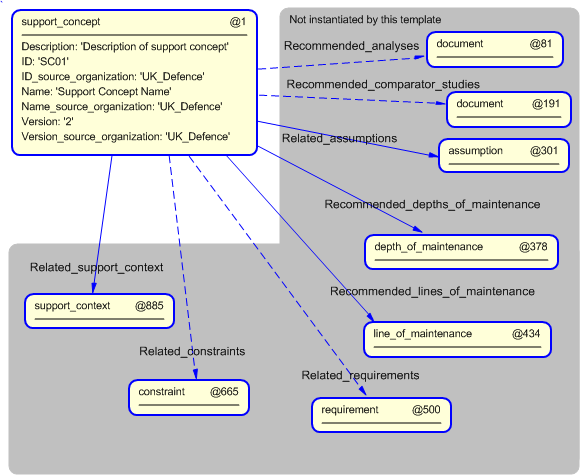Template:— support_concept (spprtcncpt)
Context:— UK_Defence |
Date: 2009/04/17 21:37:57
Revision: 1.11
|
This section specifies the template support_concept.
NOTE
The template has been defined in the context of
UK_Defence.
Refer to the business context for details of related templates.
NOTE
An explanation of a template and the associated instantiation path is
provided in the
Template overview
section.
This template describes how to represent a support concept which is defined to be the combination of:
i. Identification of the contracting strategies to be applied or explored for any aspect of support (e.g. SOM options).
ii. Guidance on the lines and levels of maintenance that should be explored or applied to any specific elements of the Platform,
System or Equipment (PSE) requiring support.
iii. The initial specification of the supportability, cost and readiness metrics that will be used to assess the design of
the support solution and the performance of the support system when it becomes operational.
The Support Concept business object is used by those UK_Defence Data Exchange Specifications that require information
about contracting strategies to be applied or explored for any aspect of support;
lines and levels of maintenance that should be explored or applied to any specific elements of a Platform, System,
or Equipment (PSE) requiring support;
and supportability, cost and readiness metrics that will be used to assess the design and performance of a support
system when it becomes operational.
Figure 1 — Graphical Representation for Business Object Support Concept
Support Concept:
The definition of an Support Concept object is:
Data about the combination of:
- Identification of the contracting strategies to be applied or explored for any aspect of support (e.g. SOM options).
- Guidance on the lines and levels of maintenance that should be explored or applied to any specific elements of the Platform,
System or Equipment (PSE) requiring support.
- The initial specification of the supportability, cost and readiness metrics that will be used to assess the design of the
support solution and the performance of the support system when it becomes operational.
|
Attribute name
|
Attribute description
|
Attribute type
|
Optionality
|
| Description |
This is description of the Support concept. |
Intrinsic |
Mandatory |
| ID |
This is the Identifier of the Support concept. |
Identifier |
Mandatory |
| Name |
This is name of the Support concept. |
Intrinsic |
Mandatory |
| Recommended analyses |
This is the reference to the documents that define the support analyses that are recommended to be undertaken for this support
concept.
|
Document |
Optional [0:?] |
| Recommended comparator studies |
This is the reference to the documents that define the comparator studies that are recommended to be undertaken for this support
concept.
|
Document |
Optional [0:?] |
| Recommended depths of maintenance |
This is the reference to depths of maintenance that are recommended for this support concept. |
Depth of maintenance |
Mandatory [1:?] |
| Recommended lines of maintenance |
This is the reference to lines of maintenance that are recommended for this support concept. |
Depth of maintenance |
Mandatory [1:?] |
| Related assumptions |
This is the reference to the assumptions from which the support concept has been derived. |
Assumption |
Optional [0:?] |
| Related constraints |
This is the reference to the constaints imposed upon development of the support concept. |
Constraint |
Optional [0:?] |
| Related requirements |
This is the reference to the requirements from which the support concept has been derived. |
Requirement |
Mandatory [1:?] |
| Related support context |
This is the reference to the support context from which the support concept has been derived |
Support context |
Mandatory |
| Version |
This is the version of the Support concept. |
Inrinsic |
Mandatory |
Table 1 — Support concept attribute details
The EXPRESS-G diagram in
Figure
2
shows the templates and EXPRESS entities that are required
to represent the template
"support_concept".
The text highlighted in blue shows the template parameters.
Figure 2 — An EXPRESS-G representation of the Information model for support_concept
The graphic for the template to be used in other EXPRESS-G diagrams
is shown in Figure
3
below.
Figure 3 — The graphical representation of the support_concept template
The following input parameters are defined for this template:
The description of the support concept.
The identifier of the support concept.
The identifier of the organization that is the source of the identifier.
The name of the support concept.
The identifier of the organization that is the source of the name.
The reference to the documents that define the support analyses that are recommended to be undertaken for this support
concept.
The reference to the documents that define the comparator studies that are recommended to be undertaken for this
support concept.
The reference to depths of maintenance that are recommended for this support concept.
The reference to lines of maintenance that are recommended for this support concept.
The reference to the assumptions from which the support concept has been derived.
The reference to the constaints imposed upon development of the support concept.
The reference to the requirements from which the support concept has been derived.
The reference to the support context from which the support concept has been derived.
The version of the support concept.
The identifier of the organization that is the source of the version number.
The following reference parameters are defined for this template:
Allow the
Task_method_version
entity instantiated in this path to be referenced when this template is used.
%^target = $support_concept.support_concept_ver%
Allow the
Task_method
entity instantiated in this path to be referenced when this template is used.
Note: The
Task_method
entity can be referenced in a template path by:
%^target = $support_concept.support_concept%
where
target
is the parameter to which the
Task_method
is bound.
The instantiation path shown below specifies the entities that are to be
instantiated by the template.
A description of templates and the syntax for the instantiation path is
provided in the
Templates Help/Information section.
-- Support concept /
representing_task_simple(
task_id=@ID,
task_id_class_name='Support_concept_identification_code',
task_id_ecl_id='urn:plcs:rdl:uk_defence',
task_org_id=@ID_source_organization,
task_org_id_class_name='Organization_name_or_identification_code',
task_org_id_ecl_id='urn:plcs:rdl:uk_defence',
task_ver_id=@Version,
task_ver_id_class_name='Version_identification_code',
task_ver_id_ecl_id='urn:plcs:rdl:std',
task_ver_org_id=@Version_source_organization,
task_ver_org_id_class_name='Organization_name_or_identification_code',
task_ver_org_id_ecl_id='urn:plcs:rdl:uk_defence',
task_name=@Name,
task_name_class_name='Support_concept_name',
task_name_ecl_id='urn:plcs:rdl:std',
task_name_org_id=@Name_source_organization,
task_name_org_id_class_name='Organization_identification_code',
task_name_org_id_ecl_id='urn:plcs:rdl:std',
task_details= @Description)/
%^support_concept_ver = $representing_task_simple.task_method_version%
%^support_concept = $representing_task_simple.task_method%
-- [optional 0:? Recommended_analyses] Document_assignmentDocument_assignment.role = '/IGNORE'
Document_assignment.assigned_document ->
^support_concept_ver
Document_assignment.is_assigned_to ->
@Recommended_analyses-- [optional 0:? Recommended_comparator_studies] Document_assignmentDocument_assignment.role = '/IGNORE'
Document_assignment.assigned_document ->
^support_concept_ver
Document_assignment.is_assigned_to ->
@Recommended_comparator_studies-- [mandatory 1:? Recommended_depths_of_maintenance] Classification_assignmentClassification_assignment.role = '/IGNORE'
Classification_assignment.items ->
^support_concept_ver
Classification_assignment.assigned_class ->
@Recommended_depths_of_maintenance-- [mandatory 1:? Recommended_lines_of_maintenance] Classification_assignmentClassification_assignment.role = '/IGNORE'
Classification_assignment.items ->
^support_concept_ver
Classification_assignment.assigned_class ->
@Recommended_lines_of_maintenance-- [optional 0:? Related_assumptions] Document_assignmentDocument_assignment.role = '/IGNORE'
Document_assignment.assigned_document ->
^support_concept_ver
Document_assignment.is_assigned_to ->
@Related_assumptions-- [optional 0:? Related_constraints] Requirement_assignmentRequirement_assignment.id = '/IGNORE'
Requirement_assignment.description = '/IGNORE'
Requirement_assignment.assigned_to ->
^support_concept_ver
Requirement_assignment.assigned_requirement ->
@Related_constraints-- [optional 0:? Related_requirements] Requirement_assignmentRequirement_assignment.id = '/IGNORE'
Requirement_assignment.description = '/IGNORE'
Requirement_assignment.assigned_to ->
^support_concept_ver
Requirement_assignment.assigned_requirement ->
@Related_requirements-- Related_support_context Activity_method_relationshipActivity_method_relationship.name = '/IGNORE'
Activity_method_relationship.description = '/IGNORE'
Activity_method_relationship.relating_method ->
^support_concept_ver
Activity_method_relationship.related_method ->
@Related_support_context
The following entities are instantiated with attributes as specified:
The instance diagram in Figure
4
shows an example of the EXPRESS entities and templates that are instantiated by the template:
/support_concept(Description='Description of support concept', ID='SC01', ID_source_organization='UK_Defence', Name='Support Concept Name', Name_source_organization='UK_Defence', Version='2', Version_source_organization='UK_Defence', Recommended_analyses='@81', Recommended_comparator_studies='@191', Recommended_depths_of_maintenance='@378', Recommended_lines_of_maintenance='@434', Related_assumptions='@301', Related_constraints='@665', Related_requirements='@500', Related_support_context='@885')/
(an illustration of the consolidated support_concept template is shown in
Figure
5 below.)
Figure 4 — Entities instantiated by support_concept template
The instance diagram in
Figure
5
shows the graphic symbol for the template that is to be
used in other instance diagrams. The example template is:
/support_concept(Description='Description of support concept', ID='SC01', ID_source_organization='UK_Defence', Name='Support Concept Name', Name_source_organization='UK_Defence', Version='2', Version_source_organization='UK_Defence', Recommended_analyses='@81', Recommended_comparator_studies='@191', Recommended_depths_of_maintenance='@378', Recommended_lines_of_maintenance='@434', Related_assumptions='@301', Related_constraints='@665', Related_requirements='@500', Related_support_context='@885')/
Figure 5 — Instantiation of support_concept template
Characterizations
No common characterizations of the template
support_concept
have been identified. However, the ISO 10303-239 EXPRESS model
may enable other assignments to the entities instantiated by the template.
